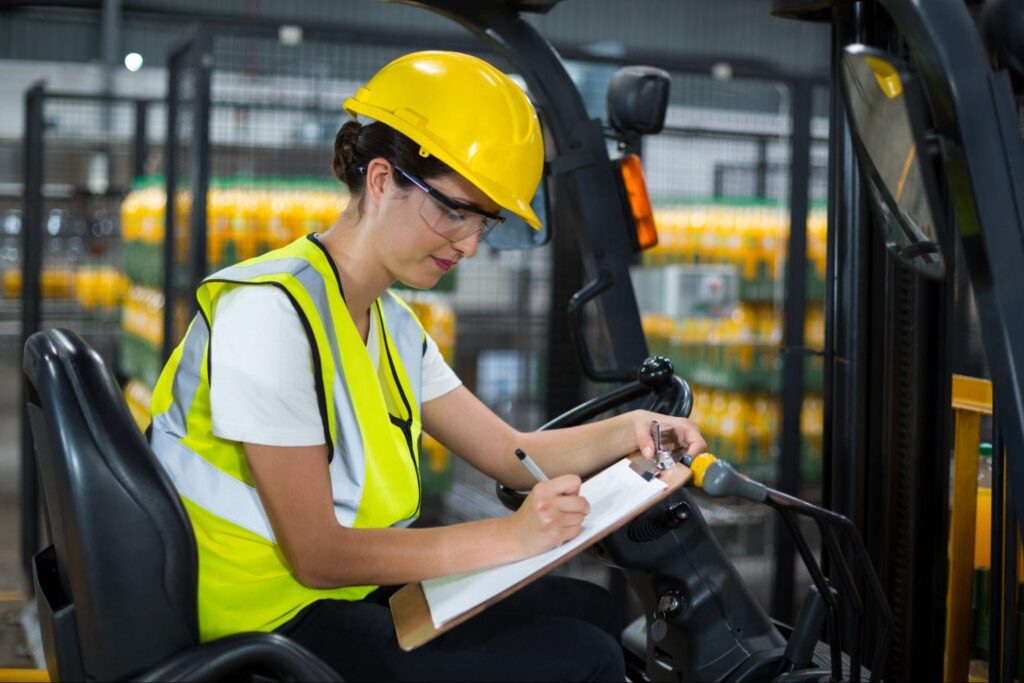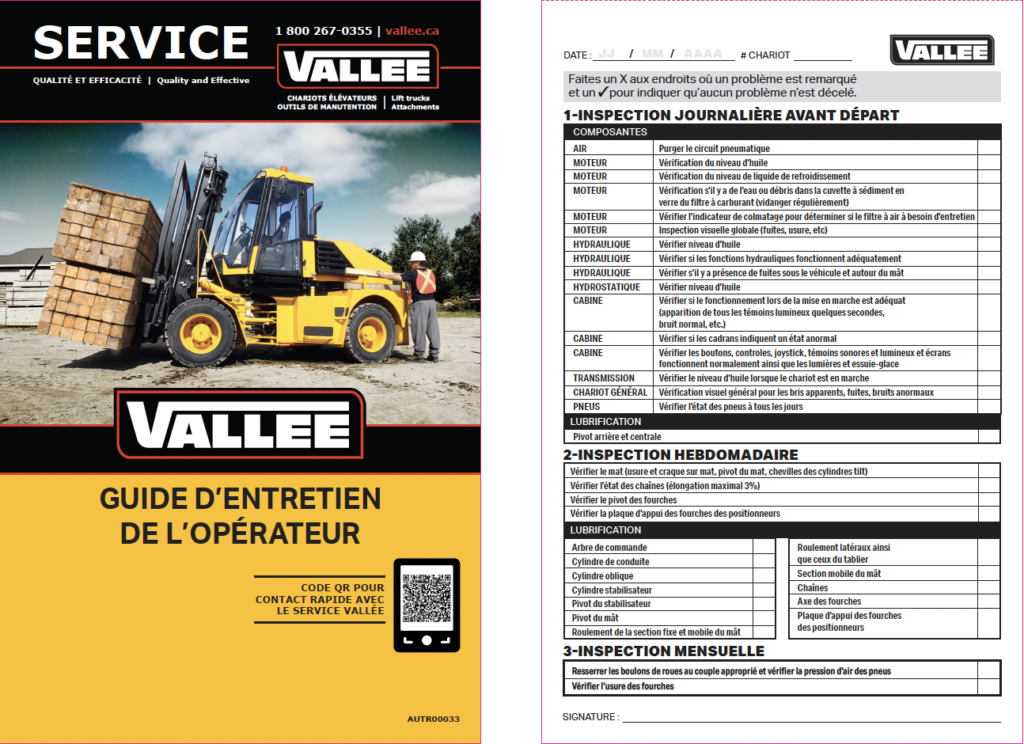Like the purchase price, maintenance costs are crucial before investing in lifting equipment. A lower purchase price may seem advantageous, but high maintenance costs can quickly reduce the savings made. In Canada and the United States, organizations like CCOHS and OSHA also impose requirements for forklift maintenance. While involving potentially significant costs, carrying out periodic maintenance is nevertheless essential. Renting a forklift can be advantageous for companies wishing to avoid these long-term maintenance costs. Many rental contracts include maintenance and repairs in the price. Discover the costs associated with forklift maintenance to plan your budget better and optimize your equipment management.

What parts should be considered?
Warehouse managers and forklift operators know it: regular maintenance of a forklift ensures its operation, efficiency, and lifespan. The safety of users also depends on proper maintenance follow-up of your lifting equipment.
Regular maintenance operations indeed reduce the risk of accidents and protect forklift drivers. A well-maintained forklift operates reliably and avoids breakdowns. When in good working condition, the tool is also more efficient, thus improving productivity. Preventive maintenance operations also decrease repair costs by preventing major problems that can occur over time.
Parts and mechanisms examined during forklift maintenance
Whether daily, weekly, or monthly, proper forklift maintenance must be carried out rigorously. Several elements must be checked:
The engine and transmission
As with all motor vehicles, it is essential to regularly check the engine oil level and replace it if necessary, using a reference recommended by the manufacturer. Regularly changing oil, air, and fuel filters also helps optimize engine performance.
Belts and pulleys are also among the parts and mechanisms that can be checked frequently. The level and condition of the coolant and the device as a whole, such as the radiator, hoses, and fan, must also be inspected to detect any leaks or obstructions.
The lift and forks
Located at the front of the forklift, the mast, forks, and lift are among the most exposed parts. Checking their condition is, therefore, essential during an inspection or maintenance. Their alignment and fixation must be given great attention, and detecting any signs of wear, deformation, or cracks should alert. The lifting chains must also be inspected to check if elements show corrosion, damage, or stretching of the links. The oil level and operation of the hydraulic system cylinders must be checked, particularly the cylinders, seals, and hoses, to avoid any risk of leakage.
Many other elements are part of the list of parts and mechanisms to check regularly on a lifting tool, whether during maintenance or before/after using your equipment. Joints generally comprise moving parts that must be periodically lubricated to ensure smooth operation and reduce wear. The lifting arms and their attachment points are also elements whose condition must be carefully checked for load handling. Tire pressure, brakes, lights, turn signals, and the battery are also essential to check.

What frequency for forklift maintenance?
Forklift maintenance is carried out at different periods. It all depends on its use and the recommendations issued by the manufacturer. Designed to exceed expectations in the most demanding environments, Vallée forklifts offer excellent resistance to wear, shocks, and thermal stresses. They are perfectly adapted to the specific needs of various sectors, such as mining or forestry operations, as well as in an industrial environment. Although these lifting vehicles are developed for extreme conditions and capable of withstanding challenging environments, they require regular maintenance to ensure proper functioning and extend lifespan. Preventive maintenance helps avoid problems and immobilizing the equipment:
Daily operations:
Before starting a lifting vehicle, the driver must check essential elements such as brakes, steering, tires, and safety devices. This practice must be implemented daily to ensure the device’s proper functioning and safety.
Periodic maintenance:
The levels of various fluids, such as hydraulic oil or engine oil, can be checked weekly in case the vehicle is frequently used. Manufacturers often recommend maintenance operations every 250 to 500 hours of use, such as changing the engine oil and oil filter, checking and replacing, if necessary, the air and fuel filters, and lubricating the various mechanisms.
Depending on the forklift’s use, a more thorough inspection of hydraulic systems, brakes, and transmission can be planned from each month to each quarter. If necessary, components subject to regular wear must be replaced.
Complete and thorough maintenance must be carried out once or twice a year. Fluids, filters, and worn parts must be replaced systematically, and the general performance of the equipment must be checked.

Some factors that influence the maintenance cost of a forklift
Several elements influence the maintenance cost of a forklift. These factors can include various criteria related to the forklift, such as the brand and model, age and condition. Other external factors, such as the operating environment and maintenance frequency, also weigh on these costs:
- The forklift model: The cost of parts and repairs differs for each. The configuration of the lifting vehicle, such as the type of mast, number of wheels, type of tires and brakes, as well as additional equipment or accessories, has an impact on the costs to be expected;
- The age and condition of the forklift: Older forklifts generally require more frequent maintenance than newer models. A forklift’s maintenance history can also have an impact on maintenance costs. For example, a forklift that has not been regularly maintained is likely to break down more often, resulting in higher costs;
- The frequency of use of the forklift: Logically, the more a forklift is used, the more expensive its maintenance. Parts wear out faster and must be replaced more often with repeated or intensive vehicle use. A forklift that operates 2,000 hours per year will have different maintenance needs than one that uses 250 hours;
- Weather conditions and operating environment: Where a forklift is used can also have an impact. For example, a vehicle used in a dusty or dirty environment requires more frequent maintenance. Difficult conditions, such as extreme temperatures, rough terrain, and steep slopes, can put extra strain on forklift components, resulting in more significant maintenance needs. This is why we recommend requesting a personalized maintenance plan;
- The quality of maintenance: Regular, high-quality maintenance helps extend the life of a forklift and prevent costly repairs. Using original parts and qualified technicians can result in higher costs but can also lead to long-term savings by reducing downtime and avoiding other problems.
Does an electric forklift have a lower maintenance cost?
Electric forklifts have some specificities compared to lifting vehicles operating with a gasoline or diesel thermal engine, particularly in maintenance costs. Unlike forklifts with an internal combustion engine, electric forklifts use fewer moving parts, drastically reducing potential failure points. Routine maintenance of an electric forklift is generally limited to draining and replacing hydraulic oils, replacing filters, and maintaining the battery. Thermal forklifts, on the other hand, require engine oil changes, air and fuel filter replacements, and ignition system adjustments, which increases labor and parts costs. Fewer components to replace or regularly maintain, thus reducing the maintenance cost of an electric forklift.
Modern electric forklift batteries are also designed to last several years with proper maintenance. Some batteries, such as lithium-ion ones, offer more constant voltage than traditional lead-acid accumulators, which reduces the load on the forklift’s electrical components and minimizes wear.
Electric forklifts thus benefit from a simpler and more efficient design, reducing maintenance costs.

How much does forklift maintenance cost?
Giving a precise figure for the maintenance cost of a forklift is complex, as each forklift is unique, and its use can vary. The age, brand, model, installed options and accessories significantly influence the frequency and cost of interventions. A forklift used in an air-conditioned warehouse with regular work cycles does not experience the same wear as a vehicle working outdoors in extreme conditions. At Vallée, the annual maintenance cost of a forklift can be included in a range of $5,000 to $20,000, depending on the level of maintenance, type of forklift, use (hours of use) and age. Don’t hesitate to ask us for a quote for customized maintenance for your forklifts.
Case of a small warehouse forklift:
Small electric forklifts for warehouses are generally more straightforward regarding mechanical design. They don’t have an internal combustion engine, complex transmission, or exhaust system, reducing the number of components requiring regular maintenance and maintenance costs.
Case of a diesel forklift:
These models are designed for heavy and outdoor applications. They operate with more complex internal combustion engines, requiring regular maintenance, including oil changes, fuel filter changes, and belt replacements. These mechanical elements increase maintenance costs, including specialized labour intervention and replacement.
Why have a maintenance plan?
Opting for a maintenance plan for your forklift allows you to avoid and anticipate significant problems. By performing regular checks and replacing worn parts before they break, you significantly reduce the risk of breakdowns and associated costs.
The maintenance plan also has other advantages:
Life extension
Regular maintenance is essential for the longevity and reliability of your forklift. By caring for your equipment, you extend its lifespan, thus maximizing your return on investment.
Downtime reduction
Forklift breakdowns lead to costly interruptions in your operations. A maintenance plan minimizes this downtime by keeping your equipment in good working order. You thus optimize your productivity.
Peace of mind
Entrusting your forklift maintenance to qualified professionals ensures that your equipment is in good hands. This allows you to focus on your core activities with peace of mind.
Higher resale value
A complete and regular maintenance history increases resale value if you sell or trade-in your forklift. Potential buyers are generally willing to pay more for well-maintained equipment.

Best tips/tricks for proper forklift maintenance
At Vallée, our main advice is to consult the user manual of your forklift at least once to know the appropriate maintenance procedures. Often, the manufacturer provides a maintenance chart to dictate what should be done and when. Call on a professional for more complex maintenance operations, such as brake adjustment or hydraulic component replacement. To properly maintain your forklift:
- Don’t perform maintenance after the first 50 hours of use when your forklift is a new model. This specific maintenance must be carried out to ensure even wear of parts and optimize the performance of your lifting vehicle;
- Strictly follow the maintenance recommendations provided by your forklift manufacturer. At Vallée, we generally offer maintenance intervals of 250, 500, 1000, and 2000 hours of use, depending on the type of machine. These periodic inspections are crucial to identify and correct any problems before they become serious, thus ensuring the reliability of the equipment in the long term;
- Follow a maintenance schedule as specified by the manufacturer. This schedule aims to ensure a machine that will operate for a long time without costly surprise stops caused by a breakdown. The price of oil is much more affordable than an engine, transmission, or pump damaged by neglected maintenance, not to mention the loss of major equipment in your operations.
- A clean forklift is a forklift that lasts longer. Clean your forklift regularly, insisting on hard-to-reach areas like the radiator and engine;
- Replace spark plugs according to manufacturer recommendations to maintain optimal engine performance. When inspecting the engine, check that there are no oil leaks, loose connections, or worn parts.
- Check chain elongation and fork wear. These are wear components that must be replaced according to their wear rate. A breakdown of these components can lead to a significant accident. Consult a forklift specialist if you don’t know how to do it.
- The standard requires a visual inspection every day before each use. To facilitate this, an inspection booklet should be found on the machine. At Vallée, we have some available. This booklet will speed up the visit of a CNESST inspector by proving that the forklift is well monitored.
Vallée Inspection Booklet

Before each use, test forward and reverse speeds to check that the forklift responds correctly and that the transmission works smoothly. Check that the pedals, handbrake, and clutch system work optimally. The excellent condition of all these elements guarantees you control of the forklift in complete safety.
Also, test the raising and lowering of the forks to ensure they work correctly and without jerking. This test allows you to verify that the hydraulic system is operational and has no malfunctions. Finally, safety devices such as the horn, lights, and backup alarm play a crucial role in accident prevention and workplace safety.
Establishing a regular inspection schedule is essential when using a forklift. It is also recommended that a person be designated responsible for implementing this schedule. A maintenance log must also be kept up to date to track the history of interventions and facilitate the management of spare parts. When an in-house repair team is operational, it must be trained in maintenance procedures and have access to the necessary technical documentation.
Setting up a checking routine is essential to regularly inspect the condition of certain vital elements on your forklift:
- The forks, which are subjected to solid stresses, should be checked frequently, especially at the level of welds and fixings, to detect any signs of wear or cracking;
- Attachments, fixings, and other accessories must be carefully inspected to ensure they are in good working order and show no play or damage;
- Side bearings and chains are critical elements of the transmission system. Correct adjustment and regular lubrication are essential to prevent their premature wear;
The cooling system should also be inspected regularly to detect leaks, limescale deposits, or obstructions. The braking system must also be tested to ensure its effectiveness and reliability.



